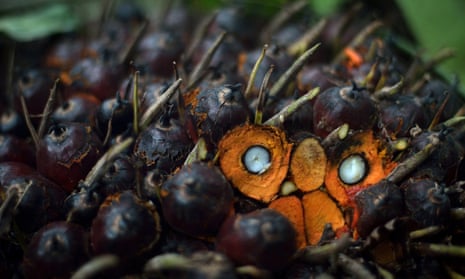In the 1940s, if a Briton hoped to include some butter or shortening in their diet they were subject to a strict set of government-imposed rations: two ounces of butter and four ounces of cooking fat per week per adult. Contrast that to today, where the products in high street supermarkets are full of cheap, mass-produced vegetable-based fats such as palm oil, soya bean oil and rapeseed oil. The most dominant of these fats is palm oil, with the WWF estimating that, from the biscuit to the soap aisle, 50% of packaged items in the grocery store now contain the ingredient.
So how did palm oil become such a widely used commodity? It was 1954 when the then-minister of food in Britain ended rationing and all food products became free-market commodities. According to Kurt Berger, a food technologist who formerly worked at major British food manufacturer J Lyons & Co, around that time research laboratories began experimenting with a new ingredient.
“One of our suppliers in Malaysia said there’s this new ingredient that’s good for frying as well as in pastries, cakes and ice cream,” Berger explains. “We tried [palm oil] out and found that not only was it technically useful, but also economically beneficial.”
Palm oil’s technical utility comes from its high melting point. Since palm oil is semi-solid at room temperature, it has a variety of uses from baking products and spreads to frying. Though animal fats also have this quality, they are far more expensive to produce.
The commodity’s cheap production cost stems from the fact that the palm plant essentially offers a two-for-one deal. Similar to a plum, both the fleshy outer part and inner stone provide usable oil (the latter referred to as palm kernel oil). The components can then be separated for different uses.
“Between the [flesh and the stone] the palm plant is about 10 times as productive as a plant like a soya bean or a rapeseed,” Berger says. “In a world that is short of food, having a plant that is as productive as that is a significant benefit.”
A perennial crop that takes up just 5% of the farmland used for vegetable oil production, palm oil makes up 38% of the global supply. It can be used not only in food but also any soap or cosmetic products that have a fatty component, for example lipstick and shampoo. In these cases, palm oil helps increase the viscosity of the product or acts as an occlusive agent, helping skin to retain its moisture. Although animal fats are still used in some cosmetics, the cost of production is simply too high for widespread use.
For palm oil’s main competitors – rapeseed, sunflower and soya bean oil – to be used in the same way, they have to be partially hydrogenated. This process turns liquid portions into more solid portions to achieve the desired butter-like consistency, but it also adds unhealthy trans fats, making commodities less desirable to consumers.
However, palm oil is far from problem free. There are major concerns about its sustainability across Asia and Africa, with fears about the impact of large-scale forest conversion, inhumane labour conditions, habitat destruction and extensive carbon emissions.
One might expect that a strong environmental coalition would be forming to rid the world of palm oil entirely, but many environmental groups seem to be taking a more practical approach. Because there simply isn’t a viable alternative, Greenpeace and others are lobbying for a more sustainable approach to palm oil production, recognising that it’s a major income source for developing countries.
“We see palm oil as a critical part of the economic development of Southeast Asia and other regions – it’s an important crop,” Greenpeace campaigner Suzanne Kroger says. Other environmental groups such as WWF and the Union of Concerned Scientists advocate a reformed palm oil industry, not an alternative commodity altogether.
The strong anti-palm oil lobby that does exist, Kroger says, largely comes from within the producing countries where local people experience the effects of land use changes and labour abuses first-hand. For now, these countries are working to make palm oil production more sustainable and efficient without the need for further deforestation. Berger cites progress in Malaysia, where producers hope a strain of the plant called elite palm will allow the country to increase production without cutting down any more forest cover.
“When you look at what these wet tropics can produce that will earn them a hard currency, it’s a very limited number of things,” Berger says. “You can limit palm oil, you can be careful about how you produce it, but I think it’s quite wrong to prevent it.”
Rosie J Spinks is a freelance journalist whose work has appeared in GOOD Magazine, Marie Claire, The Ecologist, Sierra Magazine, and EcoSalon. You can follow her writing on Tumblr.
Read more stories like this:
- From rainforest to your cupboard: the real story of palm oil - interactive
- 10 things you need to know about sustainable palm oil
- Palm oil: the secret in your shopping basket - have your say
The palm oil debate is funded by the Roundtable on Sustainable Palm Oil. All content is editorially independent except for pieces labelled advertisement feature. Find out more here.
Join the community of sustainability professionals and experts. Become a GSB member to get more stories like this direct to your inbox

Comments (…)
Sign in or create your Guardian account to join the discussion